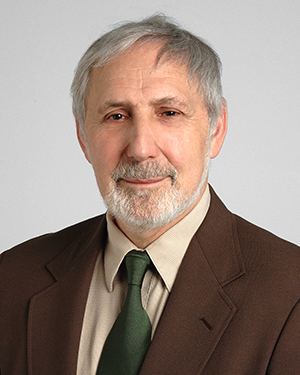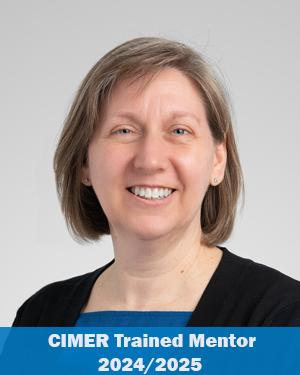Research News
07/06/2023
At 90 years old, Dr. George Stark is pursuing his next big scientific breakthrough
The former chair of the Lerner Research Institute, George Stark, PhD, was celebrated with a day-long cancer symposium with talks from collaborators and colleagues on July 7.

George Stark, PhD, turns 90 this month. The Cleveland Clinic Distinguished Scientist and principal investigator in Cancer Biology has no plans to slow down anytime soon. In fact, having recently co-secured a $12 million grant and co-authored results on a novel topical skin cancer treatment, he says he’s only looking ahead.
“It’s so important to have fun, which is easy to do when you’re in science,” Dr. Stark says.
He still believes that people are at the core of great science, which is why he enjoys coming to work every day and starts each morning with an in-person lab meeting with his team. These conversations are critical to thinking about projects in new ways and “spark” excitement about the possibilities, he says.
The Lerner Research Institute is celebrating Dr. Stark’s milestone birthday with a day-long symposium. His contributions to science and his humor are reflected in the long list of speakers, and in the titles of their talks. An example, “Fine, George! I'll work on the STATs - Balancing STAT Activity to Improve Cancer Therapies,” will be presented by Mark Jackson, PhD, a collaborator and former lab member, now at Case Western Reserve University.
With a list of scientific achievements as long as Dr. Stark’s, a day-long symposium only begins to scratch the surface on more than 50 years in science.


A new challenge at 58
Dr. Stark joined Cleveland Clinic’s Lerner Research Institute in 1992. For decades, he ran labs in the Department of Biochemistry at Stanford University and at the Imperial Cancer Research Fund in London, where he also served as associate director of research. As Dr. Stark approached England’s mandated retirement age of 62 years old, it wasn’t even a question that he would look for a new challenge.
Instead of tapering his work for retirement, Dr. Stark packed up his lab and hopped back across the pond, landing a role at Cleveland Clinic as Lerner Research Institute chair. Under his 10 years of leadership, LRI almost doubled in size.
“As scientists, the infinite reward comes in tackling the big problems. ... Don’t stop exploring the questions that matter.”

Fundamental discoveries for more than 50 years
Dr. Stark is a driving force behind many milestone discoveries. Perhaps the best known is the JAK-STAT pathway, which drives activation of the many signaling proteins involved in inflammatory and immune responses. This research is fundamental to understanding how cells respond to interferons, which are the first line of defense against pathogens.
Researchers are still investigating JAK-STAT and its catalogue of induced proteins to understand mutations that cause disease. Numerous treatments have been developed as a result of the JAK-STAT pathway, including for multiple types of cancer and immunodeficiencies. JAK-STAT was key in developing treatments for COVID-19.
Dr. Stark’s lab also developed the Northern Blotting method, now widely used to study RNA. The test’s name is a pun on the Southern blotting method; the original is named after its creator, British researcher Edwin Southern. Dr. Stark’s team then went on to create the Western Blotting method, widely used to study proteins, and scientists continued to carry the pun on, naming other tests after directions.

Collaborations, publications and mentorship
One of Dr. Stark’s long-term projects has been to use a compound nicknamed PALA – designed to block the function of an enzyme essential for DNA and RNA synthesis, first created in his lab 50 years ago.
Although initial clinical trials showed that PALA was too toxic to use as a systemic treatment for solid tumors, decades later Christine McDonald, PhD, who leads a lab in the department of Inflammation & Immunity that investigates immune pathways in the gut and skin, found that PALA has a second important activity – activating an immune pathway that fights infections and cancer. She reached out to Dr. Stark to investigate developing a cream with PALA as a treatment for skin diseases.
The team discovered that a PALA ointment was very effective in treating skin cancer in preclinical trials and is much less irritating than other current standards of care. Their findings were recently published, just a month before Dr. Stark’s 90th birthday.
Kala Mahen, first author on the study, started in Dr. Stark’s lab during her gap year before medical school and now wants to pursue leading a lab of her own. “I always wanted to be a physician. I joined the lab and then the coronavirus pandemic hit. I saw in real time how research was saving people and simultaneously, our drug started to work. And this research isn’t just affecting a subset of patients – it's affecting an entire field.”
Mahen attributes her passion for research in good part to Dr. Stark, who she says has become like family. “His knowledge is unbelievable,” she says, “I’ve gone to him with crazy ideas, and he has no problem telling me when they're awesome – and when they're not. As a young researcher, that's what you need.”
Seeing early-career and young investigators come into the lab and then go on to start their own projects is an exciting part of the job, Dr. Stark says.
“As scientists, the infinite reward comes in tackling the big problems,” he says. “It’s difficult to balance the risky unknowns when you’re a young researcher – but it’s critical. My advice to the next generation: Ask the big questions. Don’t stop exploring the questions that matter.”
Featured Experts
News Category
Related News
Research areas
Want To Support Ground-Breaking Research at Cleveland Clinic?
Discover how you can help Cleveland Clinic save lives and continue to lead the transformation of healthcare.
Give to Cleveland Clinic
